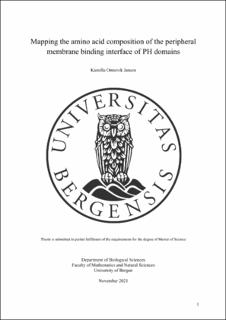Mapping the amino acid composition of the peripheral membrane binding interface of PH domains
Master thesis
Permanent lenke
https://hdl.handle.net/11250/2834968Utgivelsesdato
2021-11-24Metadata
Vis full innførselSamlinger
- Master theses [270]
Sammendrag
Biological membranes are important in the organization of cells, and the main components of membranes are different kinds of lipids. Peripheral proteins are soluble and interact transiently and bind reversibly to lipids in membranes. Pleckstrin Homology (PH) domains are protein domains found in peripheral membrane proteins, which bind to lipids called phosphatidylinositides (PIPs). Different PH domains have a well conserved structure but low sequence identity. About 15% of PH domains bind to PIPs in membranes with high affinity, but varying specificity. Characterization of the membrane binding sites in terms of amino acid content and structure is still incomplete. Thus, the main goal of this project is to fill a part of this knowledge gap by mapping the amino acid composition of the membrane binding interface (IBS) of PH domains. This was done using a bioinformatical approach as it allows to gather and analyze large datasets of protein structures and sequences. To address the aim of the project the work was divided into four subparts. I first collected datasets of PH domain sequences and structures, and aligned them. Secondly, datasets and multiple sequence alignments were analyzed to find PH domains with sequence patterns described in the literature to be important for membrane binding. The length of the IBS loops was calculated and we made an inventory of the PH domain secondary structure elements. Thirdly, the amino acid composition of the membrane binding interface was mapped. Lastly, the level of conservation of amino acids in the peripheral membrane binding interface region was calculated. The main goal of mapping the amino acid composition of the membrane binding interface of PH domains was successfully accomplished. The most important results and conclusions from the project are: 1) The level of basic amino acids follows the PIP binding pattern for canonical and non-canonical PIP binding. 2) Lysines are more common than arginines in the IBS, with only one structurally positioned exception. 3) Glycine is common in the IBS used for both types of specific membrane binding. 4) The amino acids important for specific membrane binding are also highly conserved in the PH domains which do not have the known amino acid patterns for specific binding to PIPs in membranes.
